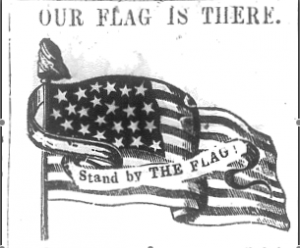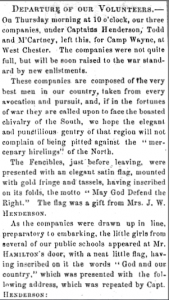My first step was to check the date that the Carlisle Fencibles were created from the American Civil War Research database. The database gave only the date of their organization at Camp Wayne. I remembered that other sources I had seen gave different dates, so I checked both the House Divided, searching for Robert Henderson, and the Blog Divided, searching for the Carlisle Fencibles. The Blog Divided had a post, Carlisle Fencibles, giving the date of their departure from Carlisle, as June 6, 1861. As I began to work with the microfilm I first looked for newspapers from the week of June 6th.
I began my search for the Carlisle Fencibles in microfilm by browsing the American Democrat, Reel #2, which had weekly issues from 1/02/1861-12/24/1862. Edited by E. Cornman, the Democrat was a pro-Douglas, Democratic newspaper. Unfortunately, as I was working with the Democrat, the scanner kept giving me problems so as of now, I do not have any scans of the articles, only notes. If time allows, I would like to get a scans of the Democrat’s articles.
On my second attempt at microfilm, in which I looked at the Republican Carlisle Herald, from 4/26/1861-9/ 28/ 1866, I had better luck. I am familiar with the Herald from prior research and this familiarity helped to me to quickly scan each issue and identify the sections most relevant to my research.
In the Herald I found a number of useful articles. One is from June 7, 1861, entitled “The Departure of Our Volunteers.” This article chronicles the departure of troops under Captains Henderson, Todd, and McCartney, from Carlisle. According to the Herald, the three companies, although not “quite full” were “composed of the very best men in our country, taken from every avocation and pursuit.” The Democrat, in a June 12, 1861 article, echoed this sentiment. It stated that the soldiers came from the “best class of our young men, some of whom have abandoned…luxurious homes, to endure the privations of camp life.”
The Herald also describes the ceremonies that took place in Carlisle just before the troops left. These included the presentation of two flags, one “elegant satin flag…with gold fringe and tassels” from Mrs. Henderson and another flag from the girls of Carlisle. Whereas the Herald’s account of the volunteers departure stresses the ceremony of the event, the Democrat stresses patriotism, stating “the patriotism of the people of Cumberland County was… made manifest by the rush of young men into the ranks of volunteer companies.”
My next step for further research would be to find the American Volunteer article on this event and compare it with the others. Also, the CCHS has a book, Defend the Colors!, which I would like to examine in order to learn more about flags in the Civil War.


